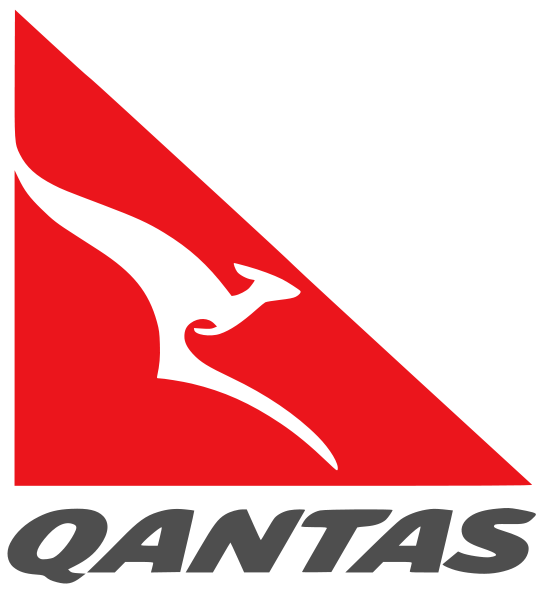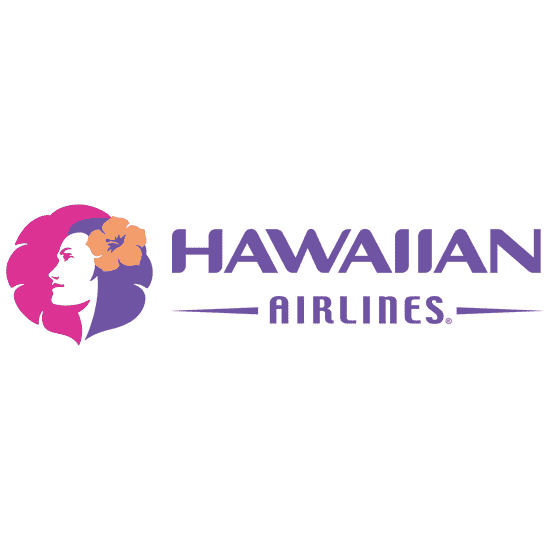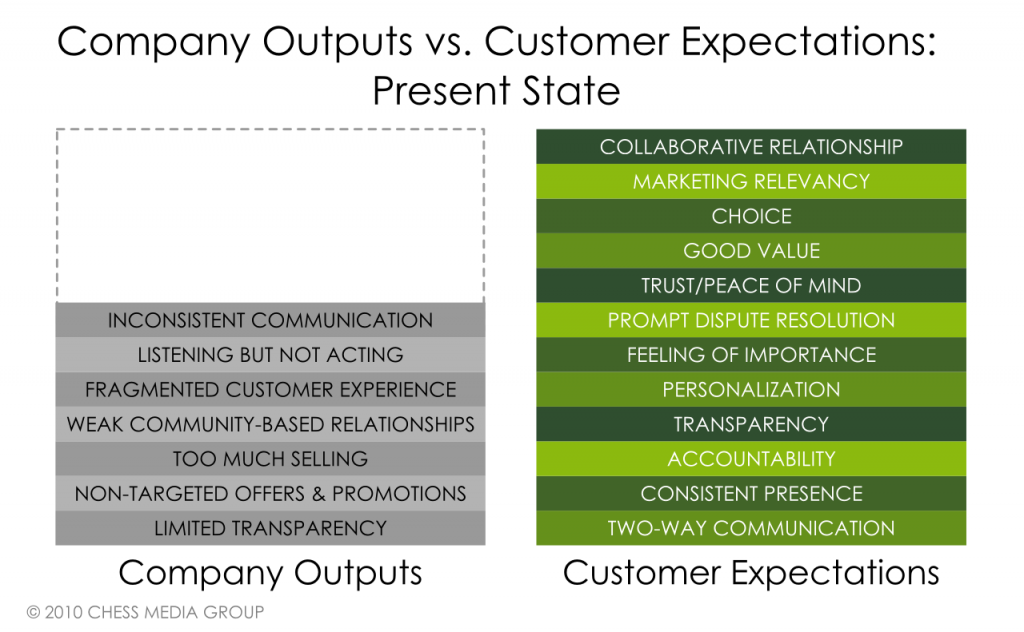We’ve been talking quite a bit about social CRM lately as I’m gearing up to present at the New Communications Forum in a few weeks. I’ve received some killer feedback on the Social CRM Process post that I wrote a few days ago. Collectively, we (myself and the community here) have identified several areas that need to be fixed. Mitch Lieberman even sent me a modified version of the diagram with some interesting ideas, but I’ll get to that in an upcoming post. For now, I want to raise another discussion topic which is the current gap between what companies are doing and what customers expect from companies. The image below depicts this gap.
Perhaps the concept would be better served designed as some sort of a balancing scale where customer expectations weight far more than company outputs, but for now this works. There might be a few other items that are missing. If so, please mention them in the comments section of this post. The goal of this image isn’t to say that companies are doing a poor job with their social CRM efforts; it’s to show that we are on the right track but that we still have a long way to go before we align ourselves with what customers actually expect brands to deliver.
Company outputs (what companies are currently doing):
- Inconsistent communication across multiple channels
- Active listening but not acting
- Fragmented customer experience across multiple channels
- Weak community-based relationships
- Too much selling
- Non-targeted offers & promotions
- Limited transparency
Customer expectations (what customers want from companies):
- Collaborative relationship
- Marketing relevancy
- Choice
- Good value
- Trust/piece of mind
- Prompt dispute resolution (customers don’t care what department you are in)
- Feeling of importance
- Personalization
- Transparency
- Accountability
- Consistent presence
- Two way communication
Keep in mind that this is a general list of items and not all of them are applicable to every company or to every customer. Again, I’m just trying to paint a broad picture of what I believe we are seeing in the social CRM space. I see this gap as a giant opportunity for companies and have a few examples to share.
 I’m currently looking for flights to Australia and New Zealand for sometime this summer. I came across a few special offers on Qantas Airlines but when I actually tried to purchase the tickets, those special offers did not appear. I contacted Qantas on Twitter and I must say their response to my issue was killer. I received a tweet and an email from Qantas asking me for a good time to chat. Within a few minutes I had the same person that manages the Twitter account on the phone with me. A very personable, friendly lady not only helped me find the offers I was looking for but also spent time with sharing information about several must-see places during my trip. Not only that, but I also received a custom made PowerPoint presentation which walked me through all the steps that I needed to go through to get those offers (this would be great to put on the website for the general community to access as I’m sure I’m not the only one having this problem). This built an emotional relationship between myself and Qantas Airlines. I can now put a voice, personality, and a name to the person behind the Twitter account (same for Qantas) and I know that if I have any other issues I will get help quickly. So when it comes time for me to purchase tickets to Australia or New Zealand, or even any destination that Qantas flies, why would I fly any other airline? (I haven’t purchased the ticket yet as I’m finalizing dates, but I will)
I’m currently looking for flights to Australia and New Zealand for sometime this summer. I came across a few special offers on Qantas Airlines but when I actually tried to purchase the tickets, those special offers did not appear. I contacted Qantas on Twitter and I must say their response to my issue was killer. I received a tweet and an email from Qantas asking me for a good time to chat. Within a few minutes I had the same person that manages the Twitter account on the phone with me. A very personable, friendly lady not only helped me find the offers I was looking for but also spent time with sharing information about several must-see places during my trip. Not only that, but I also received a custom made PowerPoint presentation which walked me through all the steps that I needed to go through to get those offers (this would be great to put on the website for the general community to access as I’m sure I’m not the only one having this problem). This built an emotional relationship between myself and Qantas Airlines. I can now put a voice, personality, and a name to the person behind the Twitter account (same for Qantas) and I know that if I have any other issues I will get help quickly. So when it comes time for me to purchase tickets to Australia or New Zealand, or even any destination that Qantas flies, why would I fly any other airline? (I haven’t purchased the ticket yet as I’m finalizing dates, but I will)
 I also booked a last minute flight to Hawaii which leaves in a few hours. I spent some time looking at flights on various sites; finally I decided to reach out to Hawaiian Airlines on Twitter. Keep in mind I was already on the purchase page for Hotwire and was ready to click the “pay” button but wanted to check if Hawaiian Airlines had some sort of specials on last minute deals. I sent out the tweet and waited a few minutes but received no response; so I just booked the flight via Hotwire. Shortly after I purchased my ticket Hawaiian got in touch with me to get more information but alas my ticket had already been purchased. They were just not fast enough.
I also booked a last minute flight to Hawaii which leaves in a few hours. I spent some time looking at flights on various sites; finally I decided to reach out to Hawaiian Airlines on Twitter. Keep in mind I was already on the purchase page for Hotwire and was ready to click the “pay” button but wanted to check if Hawaiian Airlines had some sort of specials on last minute deals. I sent out the tweet and waited a few minutes but received no response; so I just booked the flight via Hotwire. Shortly after I purchased my ticket Hawaiian got in touch with me to get more information but alas my ticket had already been purchased. They were just not fast enough.
So here we have two airlines with two very different responses; one of those airlines got my business, the other did not. Qantas solved my customer expectations of:
- Prompt resolution (had someone on the phone within a few minutes)
- Two-way communication (on Twitter, email, and phone)
- Collaborative relationships (helped me select destinations)
- Personalization (I received a custom PowerPoint presentation with steps outlining how to get the special offers)
- Feeling of importance
The gap between what I expect and what Qantas offers is small. The gap between what I expect and what Hawaiian offers is larger. Now I’m not being critical of Hawaiian Air. After all they did respond to me and they did a great job, but when I’m looking to buy right now, prompt response is everything. This is just my expectations of a brand with a presence on Twitter. I expect them to be there whenever I have a problem. Is that unreasonable? Maybe it is, but it’s still what I expect.
Sometimes it only takes one transaction to help close the gap between what a company offers and what a customer wants, case in point Qantas.
Your turn. Have any other stories, comments on the diagram, thoughts on this post? Please share.


It's funny that you turn to twitter before just calling the airline. But I think we all know that calling an airline is a lesson in futility. In the not so distant past, you could be guaranteed an immediate response to a phone call. Have our customer expectations been set to NOT expect an answer to a phone call?
Twitter has become a bit like the phone. Why call the airline, wait on hold, and go through several automated voice commands when I can connect with a real person online without having to pick up the phone? It's easier, more personal, and saves me time.
Thanks for stopping by Ben
While Twitter is shiny and new, I suspect people like you and I get fast responses on Twitter because there are so many more social media team members relative to the number of twitter requests than the ratio of call center operators to inbound phone calls, and perhaps social media fatigue has not yet set in as it has with email.
On the other hand, globalism also means that when you decide you don't want to provide a rapid response for the customer, there are three billion entrepreneurs out there ready to pick up the slack.
We've been working on a service that mashes up Google and Twitter search so employers can arm their employees with the tools to deliver faster answers. So far, the smart companies are getting sick smart and the laggards don't even know what questions they should be asking.
While Twitter is shiny and new, I suspect people like you and I get fast responses on Twitter because there are so many more social media team members relative to the number of twitter requests than the ratio of call center operators to inbound phone calls, and perhaps social media fatigue has not yet set in as it has with email.
On the other hand, globalism also means that when you decide you don't want to provide a rapid response for the customer, there are three billion entrepreneurs out there ready to pick up the slack.
We've been working on a service that mashes up Google and Twitter search so employers can arm their employees with the tools to deliver faster answers. So far, the smart companies are getting sick smart and the laggards don't even know what questions they should be asking.